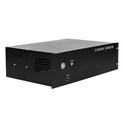Ultrasonic filtration systems are pretty cool tech, and one of the key concepts you gotta understand is ultrasonic absorption. So, what exactly is ultrasonic absorption in an ultrasonic filtration system? Let's dig into it.
First off, ultrasonic waves are high - frequency sound waves that are beyond the range of human hearing. In an ultrasonic filtration system, these waves play a crucial role. Ultrasonic absorption refers to the process where the energy of ultrasonic waves is taken in by the medium through which they are passing.
When we talk about the medium in an ultrasonic filtration system, it could be a liquid solution that contains various particles and contaminants. As the ultrasonic waves travel through this liquid, some of the wave's energy gets absorbed by the molecules in the liquid and the particles within it.
The absorption of ultrasonic waves mainly happens due to two reasons. One is viscous absorption. The liquid has a certain viscosity, and as the ultrasonic waves cause the molecules in the liquid to vibrate, the internal friction within the liquid dissipates the wave energy as heat. Think of it like when you rub your hands together. The friction between your hands generates heat, and in a similar way, the internal friction in the liquid because of the ultrasonic wave - induced vibrations leads to energy loss in the form of heat.
The other reason is molecular relaxation absorption. Molecules in the liquid have different energy states. When the ultrasonic waves interact with these molecules, they can cause the molecules to transition between different energy states. During this transition, some of the wave energy is absorbed by the molecules.
Now, why is ultrasonic absorption important in an ultrasonic filtration system? Well, it has a direct impact on the filtration efficiency. The absorbed energy can cause several beneficial effects. For example, it can increase the temperature of the liquid slightly. This increase in temperature can reduce the viscosity of the liquid, making it easier for the particles to move through the filter medium.
Also, the energy absorbed by the particles can cause them to vibrate. These vibrations can break up agglomerated particles into smaller ones. Smaller particles are much easier to filter out compared to large clumps of particles.
Let's take a look at how this works in our two main types of filtration systems. We've got the Ultrasonic Pipe Filter. In this system, the ultrasonic waves are transmitted through the pipe where the liquid is flowing. As the waves travel through the liquid in the pipe, they get absorbed, leading to the effects I just mentioned. The reduced viscosity and the break - up of particles make the filtration process more efficient. The absorbed energy also helps in preventing the build - up of particles on the filter surface, which can clog the filter and reduce its performance over time.
Then there's the Ultrasonic Tank Filter. In a tank - based system, the liquid is stored in a tank, and the ultrasonic transducers are placed in or around the tank. The ultrasonic waves spread throughout the liquid in the tank. The absorption of these waves in the tank - based liquid helps in evenly distributing the energy, ensuring that all parts of the liquid get the benefits of the ultrasonic action. This is great for filtering large volumes of liquid effectively.
But we also need to be aware of the potential downsides of ultrasonic absorption. If too much energy is absorbed, it can lead to excessive heating of the liquid. This might not be a good thing, especially if the liquid contains heat - sensitive components. It could also cause some chemical reactions to occur in the liquid, which might change the properties of the liquid and the particles being filtered.
To optimize the ultrasonic absorption in our systems, we've done a lot of research and development. We adjust the frequency of the ultrasonic waves according to the properties of the liquid and the particles we're dealing with. Different frequencies are absorbed differently by different substances. By carefully selecting the right frequency, we can ensure that the absorption is just right to achieve the best filtration results.
We also control the power of the ultrasonic waves. Higher power can lead to more energy being absorbed, but as I said, too much can be a problem. So, we find that sweet spot where we get the maximum benefits of absorption without causing any negative effects.
In addition, the design of our filters is also crucial. The material and structure of the filter can affect how the absorbed energy impacts the filtration process. We use high - quality materials that are resistant to the effects of the ultrasonic waves and can work well in combination with the absorbed energy to filter out the particles effectively.
If you're in the market for an ultrasonic filtration system, you need to understand how ultrasonic absorption works. It's a key factor that can make or break the performance of your filtration system. Whether you're dealing with industrial waste water, a chemical solution in a manufacturing process, or any other liquid that needs to be filtered, our ultrasonic filtration systems are designed to make the most of ultrasonic absorption.
Our systems are reliable, efficient, and have been proven to work in a wide range of applications. We've got years of experience in the industry, and we're constantly improving our technology to give you the best results.


If you're interested in learning more about our ultrasonic filtration systems or want to discuss your specific filtration needs, don't hesitate to reach out. We're always happy to have a chat and see how we can help you with your filtration requirements.
References
- Ultrasonic Technology in Filtration: Principles and Applications. A collection of research papers on ultrasonic filtration and related concepts.
- Handbook of Liquid Filtration. This book provides in - depth information on different filtration methods, including ultrasonic filtration.





